|
|
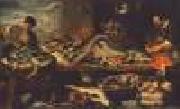 |
SNYDERS, Frans
|
|
Flemish Baroque Era Painter, 1579-1657
Flemish painter and draughtsman, active also in Italy. He was the progenitor of Flemish Baroque still-life and animal painting. He worked intensively for about 50 years, producing an enormous body of works, of which more than 300 paintings survive , along with some oil sketches and about 100 drawings. |
|
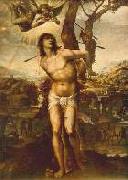 |
SODOMA, Il
|
|
Italian High Renaissance Painter, 1477-1549
Sienese painter, whose real name was Giovanni Antonio Bazzi. Born in Vercelli, Piedmont, he went to Rome c.1508. Commissioned by Pope Julius II, he painted frescoes in the Camera della Segnatura in the Vatican. Raphael's frescoes afterward replaced most of his work there. For Agostino Chigi in the Farnesina Villa, Sodoma painted two frescoes, The Marriage of Alexander and Alexander in the Tent of Darius. In Siena and its vicinity he produced many works, executed in a saccharine style. |
|
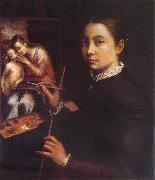 |
Sofonisba Anguisciola
|
|
1532?C1625, The best known of the sisters, she was trained, with Elena, by Campi and Gatti. Most of Vasari's account of his visit to the Anguissola family is devoted to Sofonisba, about whom he wrote: 'Anguissola has shown greater application and better grace than any other woman of our age in her endeavours at drawing; she has thus succeeded not only in drawing, colouring and painting from nature, and copying excellently from others, but by herself has created rare and very beautiful paintings'. Sofonisba's privileged background was unusual among woman artists of the 16th century, most of whom, like Lavinia Fontana (see FONTANA (ii),(2)), FEDE GALIZIA and Barbara Longhi (see LONGHI (i), (3)), were daughters of painters. Her social class did not, however, enable her to transcend the constraints of her sex. Without the possibility of studying anatomy, or drawing from life, she could not undertake the complex multi-figure compositions required for large-scale religious or history paintings. She turned instead to the models accessible to her, exploring a new type of portraiture with sitters in informal domestic settings. The influence of Campi, whose reputation was based on portraiture, is evident in her early works, such as the Self-portrait (Florence, Uffizi). Her work was allied to the worldly tradition of Cremona, much influenced by the art of Parma and Mantua, in which even religious works were imbued with extreme delicacy and charm. From Gatti she seems to have absorbed elements reminiscent of Correggio, beginning a trend that became marked in Cremonese painting of the late 16th century. |
|
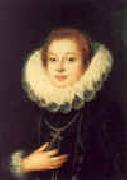 |
Sofonisba Anguissola
|
|
Italian
1532-1625
Sofonisba Anguissola was born in Cremona, Lombardy around 1532, the oldest of seven children, six of whom were daughters. Her father, Amilcare Anguissola, was a member of the Genoese minor nobility. Sofonisba's mother, Bianca Ponzone, was also of an affluent family of noble background. Her mother died when Sofonisba was four or five.
Over four generations, the Anguissola family had a strong connection to ancient Carthaginian history and they named their offspring after the great general Hannibal, thus the first daughter was named after the tragic Carthaginian figure Sophonisba.
Amilcare Anguissola encouraged all of his daughters (Sofonisba, Elena, Lucia, Europa, Minerva and Anna Maria) to cultivate and perfect their talents. Four of the sisters (Elena, Lucia, Europa and Anna Maria) became painters, but Sofonisba was by far the most accomplished and renowned. Elena became a nun (Sofonisba painted a portrait of her) and had to quit painting. Both Anna Maria and Europa gave up art upon marrying, while Lucia Anguissola, the best painter of Sophonisba's sisters, died young. The other sister, Minerva, became a writer and Latin scholar. Asdrubale, Sophonisba's brother, studied music and Latin but not painting.
Self-portrait, 1554Her aristocratic father made sure that Sofonisba and her sisters received a well-rounded education that included the fine arts. Anguissola was fourteen years old when her father sent her with her sister Elena to study with Bernardino Campi, a respected portrait and religious painter of the Lombard school, also from Cremona, Sofonisba's home town. When Campi moved to another city, Sofonisba continued her studies with the painter Bernardino Gatti (known as Il Sojaro). Sofonisba's apprenticeship with local painters set a precedent for women to be accepted as students of art.[citation needed] Dates are uncertain, but Anguissola probably continued her studies under Gatti for about three years(1551-1553).
Sophonisba's most important early work is Bernardino Campi Painting Sofonisba Anguissola (c 1550 Pinacoteca Nazionale, Siena). The double portrait depicts her art teacher in the act of painting a portrait of her.
In 1554, at age twenty-two, Sofonisba traveled to Rome, where she spent her time sketching various scenes and people. While in Rome, she met Michelangelo through the help of another painter who knew her work well. Meeting Michelangelo was a great honor for Sofonisba and she had the benefit of being informally trained by the great master.
Lucia, Minerva and Europa Anguissola Playing Chess, 1555. Museum Navrodwe, Poznan, Poland.When he made a request for her to draw a weeping boy, Sofonisba drew 'Child bitten by a crab' and sent it back to Michelangelo, who immediately recognized her talent (this sketch would continue to be discussed and copied for the next fifty years among artists and the aristocracy)
Michelangelo subsequently gave Anguissola sketches from his notebooks to draw in her own style and offered advice on the results. For at least two years Sofonisba continued this informal study, receiving substantial guidance from Michelangelo.
|
|
|
|
|
|
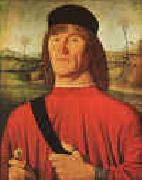 |
Solario
|
|
1460-1524
Italian
Solario Gallery |
|
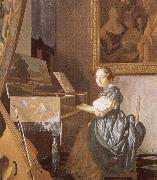 |
solomon eccles
|
|
also known as Solomon Eagle (1618 - 1683) was an English composer.
Little if any of his works are extant since, when he became a Quaker, he burned all his books and compositions so as to distance himself from church music. His repugnance for the organised church showed in his name for them: "steeple-houses".
|
|
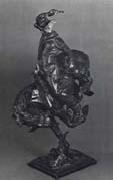 |
Solon H. Borglum
|
|
American Sculptor, 1868-1922,was an American sculptor. Born in Ogden, Utah, he was the younger brother of Gutzon Borglum and uncle of Lincoln Borglum of Mount Rushmore fame. The son of Danish immigrants who settled on the great plains, Solon Borglum spent his early years as a rancher in western Nebraska. Though he later lived in Paris and New York and achieved a reputation as one of America's best sculptors, it was his depiction of frontier life, and especially his experience with cowboys and native American peoples, on which his reputation was founded. Borglum studied under Louis Rebisso in Cleveland and in Paris. He specialized in depicting people and scenes of the American West. He moved to the Silvermine neighborhood of New Canaan, Connecticut, where he helped found the "Knockers Club" of artists. His brother, Gutzon, lived in nearby Stamford, |
|
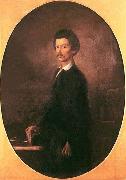 |
Soma Orlai Petrich
|
|
(October 22, 1822, Mezőbereny - June 5, 1880, Budapest) was a Hungarian painter. Petrich was born to a Serbian father and Hungarian mother.
He originally wanted to become a writer. He was a pupil of Jakab Marastoni in 1846 and attended Ferdinand Georg Waldmeller's school in Vienna from 1847. He often painted historical themese and in his lithographs he portrayed experiences during the war of independence. He studied from Kaulbach in Munich from 1850. He painted "The Corpse of Louis II" in 1851, a decade before Bertalan Szekely's painting. He was also a popular portraitist.
|
|
|
|
|
|
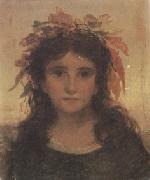 |
Sophie anderson
|
|
1823-1903
was a French-born British artist who specialised in genre painting of children and women, typically in rural settings. Her work is loosely associated with the Pre-Raphaelite movement. She was the daughter of Charles Gengembre, a Parisian architect, and his English wife. She was largely self-taught, but briefly studied portraiture with Charles de Steuben in Paris in 1843. The family left France for the United States to escape the 1848 revolution, They first lived in Cincinnati, Ohio, then in Manchester, Pennsylvania, where she met and married the British genre artist Walter Anderson. She initially worked in portraiture, including work for the chromolithographers Louis Prang & Co.. In 1854 the Andersons moved to London, where she exhibited her works in the Royal Academy. They returned to New York in 1858, then finally settled in London around 1863. Over the next three decades, her work was widely shown at venues including the Royal Academy, the Society of British Artists and many regional galleries. |
|
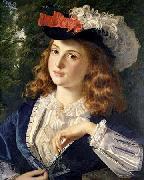 |
Sophie Gengembre Anderson
|
|
Sophie Gengembre Anderson (1823 - 10 March 1903) was a French-born British artist who specialised in genre painting of children and women, typically in rural settings. Her work is loosely associated with the Pre-Raphaelite movement.
Sophie was born in Paris, the daughter of Charles Gengembre, an architect, and his English wife. She had two brothers, Philip and Henry P. She was largely self-taught in art, but briefly studied portraiture with Charles de Steuben in Paris in 1843. The family left France for the United States to escape the 1848 revolution, first settling in Cincinnati, Ohio, then Manchester, Pennsylvania, where she met and married British genre artist Walter Anderson.
|
|
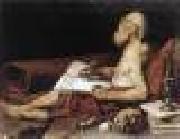 |
SPADA, Lionello
|
|
Italian Baroque Era Painter, 1576-1622
Italian painter, active mainly in Emilia. His signature was an L placed across a sword [Ital. spada=sword]. His work shows influence of the grand manner of the Carracci, as in The Burning of Heretical Books (San Domenico, Bologna), and of Caravaggio's naturalism, seen in dramatic religious and genre scenes such as The Way to Calvary (Parma). In his late works his manner became softer and warmer under Correggio's influence. An example is The Marriage of St. Catherine (Parma). |
|
|
|
 |
Spencer Stanhope
|
|
British
1829-1908
Stanhope was the son of John Spencer Stanhope of Horsforth and Cannon Hall, MP, a classical antiquarian who in his youth explored Greece. The artist??s mother was Elizabeth Wilhemina Coke, third and youngest daughter of Thomas William Coke of Norfolk, first Earl of Leicester; she and her sisters had studied art with Thomas Gainsborough. Stanhope had one older brother, Walter, who inherited Cannon Hall, and four sisters, Anna Maria Wilhelmina, Eliza Anne, Anne Alicia, and Louisa Elizabeth. Anna married Percival Pickering and became the mother of Evelyn.
Not inheriting the family estates left Stanhope free to make a commitment to art. While a student at Oxford, he sought out Watts as a teacher and was Watts?? assistant for some of his architectural paintings. Spencer-Stanhope traveled with Watts to Italy in 1853 and to Asia Minor in 1856?C57. Upon his return, he was invited by Dante Gabriel Rossetti to participate in the Oxford murals project, painting Sir Gawaine and the Damsels.
On January 10, 1859, he married Elizabeth King, the daughter of John James King, granddaughter of the third Earl of Egremont, and the widow of George Frederick Dawson. They settled in Hillhouse, Cawthorne, and had one daughter, Mary, in 1860. That same year, Spencer-Stanhope??s house Sandroyd (now called Benfleet Hall), near Cobham in Surrey, was commissioned from the architect Philip Webb. Finished by 1861, Sandroyd was only Webb??s second house, the first having been built for William Morris. The house was designed to accommodate Stanhope??s work as a painter, with two second-floor studios connected by double doors, a waiting room, and a dressing room for models. The fireplace featured figurative tiles designed by Burne-Jones based on Chaucer??s dream-vision poem The Legend of Good Women. For a person of Stanhope??s social standing, the house was considered ??a modest artist??s dwelling.?? Burne-Jones was a frequent visitor to Sandroyd in the 1860s, and the landscape furnished the background for his painting The Merciful Knight (1964), the design of which Stanhope??s I Have Trod the Winepress Alone is said to resemble.
The move was intended to offer an improved environment for Stanhope??s chronic asthma. When his condition was not alleviated, he turned to wintering in Florence. In the summers, he at first stayed at Burne-Jones??s house in London and later at the Elms, the western half of Little Campden House on Campden Hill, the eastern half of which was occupied by Augustus Egg.
In 1867, at the age of seven, Mary died of scarlet fever and was buried in at the English Cemetery in Florence. Her father designed her headstone.
Though his family accepted his occupation as a painter and took a great interest in art, Evelyn??s parents disparaged the achievements of ??poor Roddy?? and regarded the painters with whom he associated as ??unconventional.?? Considered among the avant-garde of the 1870s, Stanhope became a regular exhibitor at the Grosvenor Gallery, the alternative to the Royal Academy.
Stanhope moved permanently to Florence in 1880. There he painted the reredos of the English Church, and other work in the Chapel of Marlborough College. In 1873, he bought the Villa Nuti in Florence, where he was visited frequently by de Morgan and where he lived until his death.
De Morgan??s sister, A.M.W. Stirling, wrote a collection of biographical essays called A Painter of Dreams, including reminiscences of her uncle, ??the Idealist, the seer of exquisite visions.?? During the 19th and early 20th century, the extended Spencer-Stanhope family included several artists, whose ties were the theme of a 2007 exhibition, Painters of Dreams, part of the 50th anniversary celebration of the opening of Cannon Hall to the public as a museum. Featured were paintings by Stanhope and de Morgan, along with ceramics by her husband, William de Morgan; bronzes by Gertrude Spencer-Stanhope; and the ballroom at Cannon Hall and ??Fairyland?? in the pleasure grounds, which were designed by Sir Walter and his daughter Cecily.
|
|
 |
Spinello Aretino
|
|
Italian Early Renaissance Painter, ca.1350-1410
was an Italian painter, the son of a Florentine named Luca, who had taken refuge in Arezzo in 1310 when exiled with the rest of the Ghibelline party. Spinello was a pupil of Jacopo del Casentino, a follower of Giotto, and his own style was a sort of link between the school of Giotto and that of Siena. In the early part of his life he worked in Florence as an assistant to his master Jacopo while painting frescoes in the church of the Carmine and in Santa Maria Novella. Between 1360 and 1384 he was occupied in painting many frescoes in and near Arezzo, almost all of which have now perished. After the sack of Arezzo in 1384 Spinello returned to Florence, and in 1387-1388 with some assistants covered the walls and vault of the sacristy of San Miniato of Florence with a series of frescoes, the chief of which represent scenes from the life of Saint Benedict. These still exist, though in a sadly restored condition; they are very Giotto-like in composition, but have some of the Siena decorative brilliance of color. In 1391-1392 Spinello was painting six frescoes, which still remain on the south wall of the Pisan Campo Santo, representing miracles of St. Potitus and St. Ephesus. For these he received 270 gold forms. Among his later works the chief are the very fine series of frescoes painted in 1407-1408 on the walls and vault of a chapel in the municipal buildings of Siena; these also have suffered much from repainting, but still are the finest of Spinello's existing frescoes. Sixteen of these represent the war of Frederick Barbarossa against the republic of Venice. |
|
|
|
|
|
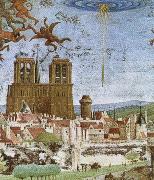 |
st ambrose
|
|
Milan; feast day December 7) Bishop of Milan. Raised in Rome, he became a Roman provincial governor. As a compromise candidate, he was unexpectedly elevated from unbaptized layman to bishop of Milan in 374. He established the medieval concept of the Christian emperor as subject to episcopal advice and censure when he forced the emperor Theodosius to seek forgiveness from the bishop, and he opposed tolerance for adherents of Arianism. He wrote theological treatises influenced by Greek philosophy, including On the Holy Spirit and On the Duties of Ministers, as well as a series of hymns. His brilliant sermons and personal example converted St. Augustine. |
|
|
|
 |
staffan hallstrom
|
|
Staffan Hallström, född 1914 i Stockholm, död 1976, var en svensk målare och tecknare.
Staffan Hallström föräldrar var Gustaf Hallström, antikvarie vid Statens historiska museum och Astrid Hallström, född Berg. Han studerade på Gerlesborgsskolan, Tekniska skolan 1932-34 och vid Kungliga Konsthögskolan i Stockholm 1935-41 för bland annat Isaac Grenewald och Olle Hjortzberg 1935-41. Han företog studieresor till Frankrike, Italien, Nederländerna och Belgien.
Staffan Hallström bodde och arbetade under 1940-talet i Saltsjö-Duvnäs, där han hyrde rum av konstnären Olle Nyman. Han fick då kontakt med Evert Lundqvist, som inspirerade honom och gav honom stöd. Tillsammans med Olle Nyman, Evert Lundqvist och Roland Kempe ingick han i Saltsjö-Duvnäs-gruppen. Senare hade han även atelje på Varvsgatan och kombinerad bostad och atelje vid Brunkebergstorg.
År 1946 hade han sin debututställning på Konstnärshuset i Stockholm. Han slog igenom med utställningen Hundra målningar på Konstakademien 1961 och spåddes då lysande framtid framför allt av skulptören Torsten Renqvist.
Staffan Hallström, arbetade i nyexpressionistisk stil och bland hans mest kända verk är Ingens hundar från 1958, som köptes in av Moderna museet. Detta motiv målade han sedan i olika versioner. Tillsammans med Lasse Andreasson gestaltade han 1972 Masmos tunnelbanestation med verket Ta ned solen i tunnelbanan, målningar på plåt utefter spårväggarna. Han är representerad på bland annat Moderna och Nationalmuseum. .
|
|
|
|
|
|
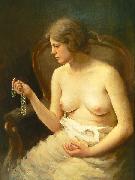 |
Stanislav Feikl
|
|
(November 12, 1883-January 7, 1933) was a Czech painter.
He studied at the School of Applied Arts and at the Prague Academy of Fine Arts. For inspiration, he toured Russia, Turkey, Dalmatia and northern Italy. He is known for his pictures of old Prague, rural areas and portraits of women, including naked. He painted impressionist paintings. |
|
|
|
 |
Stanislaw Chlebowski
|
|
(1835-1884) was a Polish painter with Russian and Turkish connections. He was a renowned specialist in oriental themes.
Chlebowski was born in Podole, and learned drawing in Odessa. Between 1853-1859, he studied at the Academy of Fine Arts in St. Petersburg, and then on a scholarship for six years in Paris as the pupil of the French orientalist painter Jean-Leon Gerôme. Chlebowski traveled to Spain, Italy, Germany, and Belgium. His first success was selling his painting "Joanne deArc in Amiens prisone to Napoleon III of France
In the years 1864-1876 Chlebowski was master painter for Sultan Abdelaziz and took up residence in Constantinople. Chlebowski became popular with the Sultanate. During his services, he had obtained permission to bring with him a large Icon of Mother of God Leading our Way having been rescued from a Odegon Monastry in 1453. He had come across it in one of the magasins with old relics, unheeded by the Ottoman keeper. This account is certified in a letter by Comite National Polonais a Constantinople, dated June 27, 1938.
In 1876 he moved to Paris. In 1881 he returned permanently to Krakow. The subject matter of his watercolors and oil paintings is diverse. He painted images of historical battles related to the history of Turkey, oriental genre scenes, landscapes, and portraits of Sultans. He died near Poznae in Kowanewko at age 49.
Chlebowski lived abroad for a long time and as a result his paintings were very rare in Poland. The National Museum in Krakow houses some of his other important Orientalist works such as "Entree de Mahomet II e Stamboul".
|
|
|
|
 |
Stanislaw Ignacy Witkiewicz
|
|
Polish Painter, 1885-1939
.Polish writer, art theorist, painter and photographer. He was the son of the architect, painter and critic Stanislaw Witkiewicz (1851-1915), creator of the 'Zakopane style' |
|
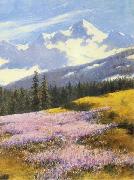 |
Stanislaw Witkiewicz
|
|
(8 May 1851 in Pašiaušė - 5 September 1915 in Lovran) was a Polish painter, architect, writer and art theoretician.
Witkiewicz was born in the Lithuanian village of Pašiaušė (Polish: Poszawsze) in Samogitia, at that time, in the partitioned Polish-Lithuanian Commonwealth lands ruled by the Russian Empire.
Witkiewicz studied in Saint Petersburg, 1869-71, then in Munich, 1872-75.
He created the Zakopane Style (styl zakopiaki) (also known as Witkiewicz Style (styl witkiewiczowski)) in architecture. He was strongly associated with Zakopane and promoted it in the art community.
His son, Stanisław Ignacy Witkiewicz, became a famous painter, playwright, novelist and philosopher, also known (from the conflation of his surname and middle name) by the mononymous pseudonym "Witkacy." The son's godmother was the internationally famous actress Helena Modjeska (Helena Modrzejewska), whom the elder Witkiewicz in 1876 had nearly accompanied to California in the United States.
Witkiewicz had strong views against formal education: "school is completely at odds with the psychological make-up of human beings". He applied this principle in his son's upbringing and was disappointed when the 20-year-old Witkacy chose to enroll at the Academy of Fine Arts in Krakew.
In 1908, suffering from tuberculosis, the elder Witkiewicz left his family in Zakopane and relocated to Lovranno, a fashionable resort in what was then Austria-Hungary, which today is in Croatia. He died there in 1915.
|
|
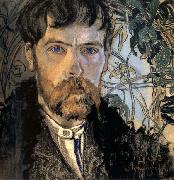 |
Stanislaw Wyspianski
|
|
1869-1907
was a Polish playwright, painter and poet, as well as interior and furniture designer. A patriotic writer, he created a series of symbolic, national dramas within the artistic philosophy of the Young Poland Movement. Wyspiaeski was one of the most outstanding and multifaceted artists of his time in Europe. He successfully joined the trends of modernism with themes of the Polish folk tradition and Romantic history. Unofficially, he came to be known as the Fourth Polish Bard. Stanisław Wyspiaeski was born to Franciszek Wyspiaeski and Maria Rogowska. His father, a sculptor, owned an atelier on Wawel Hill. His mother died of tuberculosis in 1876 when Stanisław was seven years old. Due to alcohol problem, Stanisław's father could not fulfil his parental responsibilities. Stanisław was adopted by his aunt Joanna Stankiewiczowa and her husband Kazimierz. The Stankiewicz family belonged to a bourgeois and intellectual class. In their house Wyspiaeski became acquainted with painter Jan Matejko, who was a frequent visitor. Matejko soon recognized that the boy had artistic talent and gave him the first artistic guidance. Wyspiaeski attended Saint Anne's Secondary. The school was unique for several reasons. Firstly, although Polish language was forbidden in educational institutions under foreign rule, the lectures in Saint Anne's Gymnasium were delivered in Polish. Secondly, the teacher's goal was to equip the students with a thorough knowledge of Polish history and literature. Thirdly, the school graduates, which included Lucjan Rydel, Stanisław Estreicher and Henryk Opieeski, were considered prominent figures in Krakew's cultural life. As a student Wyspiaeski did not display any specific talent, but took particular interest in art and literature. According to Joanna Stankiewiczowa, a young Stanisław portrayed small village cottages, animals, plants, armors and decorations. As far as literature was concerned, Wyspiaeski created a dramatic interpretation of Matejko's painting Stefan Batory pod Pskowem (Bathory at Pskov). In 1887 Wyspiaeski enrolled in the Philosophy Department at the Jagiellonian University and the School of Fine Arts in Krakew. While studying at the University, he attended lectures in art, history and literature. Jan Matejko, the dean of the School of Fine Arts soon recognized Wyspiaeski's talent and asked him to join in the creation of a polychrome inside the Mariacki Church. The years 1890-1895 were devoted to traveling. Wyspiaeski visited Italy, Switzerland, Germany, Prague and France. The stay in France was regarded to be the major point in his artistic life. He studied at the private atelier Academie Colarossi. Since the school fee was very high, Wyspiaeski applied for a grant. During the stay in France he got acquainted with Paul Gauguin. Together they visited art museums, where Wyspiaeski was bewitched by the beauty of Pierre Puvis de Chavannes's paintings. He also attended theatre performances based on Shakespeare's and antic plays. His future dramas: Daniel i Meleager (Daniel and Meleagra) and Powret Odysa (Return of Odysseus) were based on the antic tradition. Meanwhile, he worked on several dramas Krelowa Polskiej Korony (The Queen of Polish Crown), Warszawianka (Varsovian Anthem) and the first version of Legenda (Legend). The play Legenda (Legend) was based on the famous Polish legend about Wars and Sawa. In August 1894 he returned to Krakew, where he got involved in the modernist movement. It was then he designed and partially made a polychrome for the Franciscan Church that was composed of flowery, geometrical and heraldic motifs. Moreover, the prior of the church encouraged Wyspiaeski to design various stained glass windows such as Blessed Salomea, Saint Francis Stigmata and God the Father. It is worth mentioning that Wyspiaeski received an award of the Polish Academy of Learning for the landscape of the Kopiec Kościuszki (Kościuszko Mound). |
|
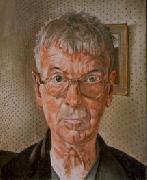 |
stanley spencer
|
|
English painter and daughtsman.
Spencer received his first formal training in 1907 at the Maidenhead Technical Institute, Berkshire. A year later he enrolled at the Slade School, London, where, as a day student nicknamed 'Cookham' by his fellow students, he remained until 1912. In that year his painting the Nativity (London, U. Coll.) was awarded both the Melville Nettleship and the Composition prizes. It shows the wide range of his early influences, from 15th-century Renaissance painting to the Pre-Raphaelites and Post-Impressionism: just as Gauguin's Yellow Christ (1889; Buffalo, NY, Albright-Knox A.G.) was set in Pont Aven, Spencer's similarly Neo-primitive Holy Family is placed in Mill Lane, Cookham. By then Spencer had firmly established his birthplace at the centre of his spiritual universe. He wrote, 'When I left the Slade and went back to Cookham, I entered a kind of earthly paradise. Everything seemed fresh and to belong to the morning. My ideas were beginning to unfold in fine order when along comes the war and smashes everything.'
|
|
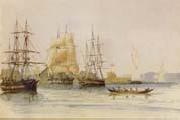 |
Stanley, Owen
|
|
1811 - 1850,was commander of HMS Rattlesnake on a four year exploratory expedition to New Guinea, 1846?C1850. Stanley was the son of Edward Stanley, Bishop of Norwich. He left naval college at the age of fifteen, and served under Phillip Parker King on HMS Adventure and John Franklin in the Mediterranean. In 1836 he sailed to the Arctic as scientific officer on HMS Terror under George Back. In 1838 he was given command of HMS Britomart and sailed to Australia, returning in 1843. In December 1846 Stanley sailed from Portsmouth in charge of HMS Rattlesnake, with the purpose of surveying the seas around the Great Barrier Reef and Torres Strait. The ship called at Madeira, Rio de Janeiro, Simon's Town and Mauritius, arriving in Sydney in July 1847. |
|
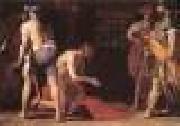 |
STANZIONE, Massimo
|
|
Italian Baroque Era Painter, 1585-1656
Italian painter. Primarily a painter of altarpieces and frescoes, his large production and vast following of students and imitators made him perhaps the leading Neapolitan painter in the first half of the 17th century. He was known as the great rival of Jusepe de Ribera, and for most of the 1630s and 1640s he and Ribera dominated painting in Naples. Stanzione's rich colour and idealized naturalism, for which he was called 'il Guido Reni napoletano', definitively influenced numerous local artists and remained discernible in the earliest works (1670s) of Francesco Solimena. Only a few portraits and mythological paintings by Stanzione are known, |
|
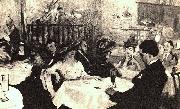 |
stefan Dimitrescu
|
|
(January 18, 1886 - May 22, 1933) was a Romanian Post-impressionist painter and draftsman.
Born in Huşi into a modest family, he completed his primary and secondary studies in his hometown. In 1902, deciding to follow his passion for music, he left for Iaşi, where he took cello classes at the Iaşi Conservatory.
In summer of 1903, Dimitrescu entered the National School of Fine Arts in the city, studying in the same class as Nicolae Tonitza; the two studied under Gheorghe Popovici and Emanoil Bardasare. After graduation, Dimitrescu painted murals for the Orthodox churches in Agăş and Asău (Bacău County). |
|
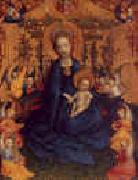 |
Stefan Lochner
|
|
German painter (b. ca. 1400, Meersburg am Bodensee, d. 1451, Köln
was a German late Gothic painter.
His style, famous for its clean appearance, combined Gothic attention towards long flowing lines with brilliant colours with a Flemish influenced realism and attention to detail.
He worked mainly in Cologne, Germany, and his principal work is the triptych of the Altar of the City Patrons (done in the 1440s, which is in the Cologne Cathedral), which represents the city in homage to the infant Jesus. The epitome of his style is Madonna of the Rose Bower (c. 1450, housed in the Wallraf-Richartz Museum in Cologne), showing the Virgin and Child reposing in a blooming rose arbor and attended by Lochner's characteristic child Angels. |
|
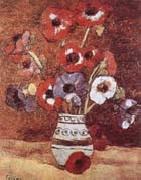 |
Stefan Luchian
|
|
Romanian Painter, 1868-1916
Romanian painter. He studied at the School of Fine Arts in Bucharest, graduating in 1889 and continuing his studies at the Akademie der Bildenden Kenste in Munich and in Paris at the Academie Julian, where he was a student of William-Adolphe Bouguereau. He rejected the rigidity of academic painting early in his career, however. The Last Autumn Race (1892; Bucharest, Mus. A.), one of the few paintings known from this period, clearly illustrates the influence of Manet and Impressionism on his early work. On his return to Romania in 1892 Luchian, unwilling to restrict his work to merely copying the French artists, struggled to create an original style. In 1900 he was left partially paralysed by a spinal disease, but he continued to work, and it is during the next years that he created his most accomplished works. His self-portraits (e.g. 1907; Bucharest, Mus. A.) are clear evidence of his determination to overcome this personal tragedy; far from inspiring pity, these paintings emphasize the depth and the strength of his inner life. It is in landscapes such as Willows at Chiajna (c. 1907; Cluj-Napoca, Mus. A.), however, that his commitment becomes even more apparent, with joyful rhythms created by means of broad brushstrokes and contrasts of bright colours next to delicate tones. Towards the end of his life Luchian became completely immobilized. During this time flowers were his favourite subject (e.g. Safta, the Flower Girl; Bucharest, N. Mus. A.; see also ROMANIA, fig. 9), and they became a metaphorical bridge between the artist and the outside world. The colours are still bright in these last paintings, and the loss of pastel tones makes the contrast more dramatic. |
|
|
|
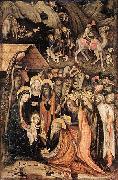 |
Stefano da Verona
|
|
Stefano da Verona. Dating to 1434, it is currently housed in the Pinacoteca di Brera of Milan, northern Italy.
|
|
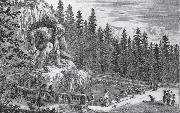 |
Stefano della Bella
|
|
Italian Baroque Era Printmaker, 1610-1664,was an Italian printmaker known for etchings of many subjects, including military ones. He was born at Florence, and apprenticed initially to a goldsmith, but became an engraver working under Orazio Vanni and then Cesare Dandini. He studied etching under Remigio Cantagallina, who had also been the instructor of Jacques Callot, who had lived in Florence 1612-1621, and whose prints imparted a strong influence to printmakers. The patronage of Don Lorenzo de Medici enabled della Bella to study for three years in Rome. In Rome, he created a then admired print of the cavalcade celebrating the entry of the Polish ambassador into Rome in 1633. He also created a number of prints of views of Rome. In 1642 he went to Paris, introduced by the Tuscan ambassador, Alessandro del Nero, and where he resided for seven years. Cardinal Richelieu engaged him to go to Arras and make drawings of the siege and taking of that town by the royal army. After residing a considerable time at Paris he returned to Florence, where he obtained a pension from the grand duke, whose son, Cosimo de Medici, he instructed in drawing. His productions were very numerous, amounting to over 1000 separate pieces. He is known to have illustrated some discoveries for Galileo. See entry for Hansken for his etching of the famous elephant after death. Wikimedia Commons has media related to: Stefano della Bella |
|
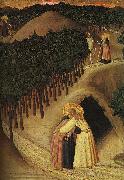 |
Stefano di Giovanni Sassetta
|
|
1423-1451
Italian
Stefano di Giovanni Sassetta Gallery
Stefano di Giovanni, known as il Sassetta, (Siena 1392 ?C 1450 or 1451) was an Italian painter. He was born in Siena, although there is also an hypothesis that he was born in Cortona. However, the first historical record of him was in Siena in 1423. Di Giovanni was probably the apprentice of Paolo di Giovanni Fei although it is also thought that he may have studied under Benedetto di Bindo. He painted in the semi-archaic Sienese School style of painting. Francesco di Giorgio e di Lorenzo, better known as Vecchietta, is said to have been his apprentice. |
|
|
|
|
|
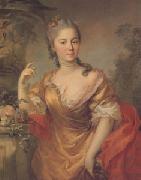 |
Stefano Torelli
|
|
Bologna 1712-St Petersburg 1784
was an Italian painter. He was born in Bologna. He studied first under his father, Felice Torelli, and then under Francesco Solimena. The future King of Poland, Augustus III, brought him to Dresden in 1740, where he painted altar-pieces and ceiling decorations, many destroyed in the Seven Years' War. He painted figures in Canaletto's twenty-nine views of Dresden (1741). In 1762 he was summoned to the Russian court where he painted ceilings in the Royal Palace, and some portraits, among the latter one of the Empress Elizabeth in armor. He was a clever caricaturist, and etched a few plates. He died in St. Petersburg. |
|
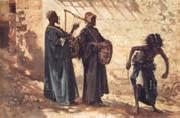 |
Stefano Ussi
|
|
Italian, 1822-1901,Italian painter. He received his formal training at the Accademia delle Belle Arti in Florence (1837-50, expelled 1838-40) under Tommaso Gazzarini (1790-1853), Pietro Benvenuti and Giuseppe Bezzuoli. In 1854 he won a scholarship to study in Rome and for several years worked on the large-scale painting that established his reputation, the Expulsion of the Duke of Athens from Florence |
|
|
|
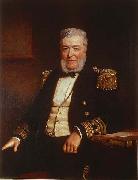 |
Stephen Pearce
|
|
(London, 1819-904) was a portrait and equestrian painter. Forty-four portraits which he painted are in the National Portrait Gallery in London, which also contains two self-portraits.
|
|
|
|
 |
Stettheimer Florine
|
|
American Painter, 1871-1944
was an American artist. She has been described as "a Deco-influenced early Modernist who??s never really gotten her due". Stettheimer was born in Rochester, New York to a wealthy family. She spent much of her early life traveling, studying art in Italy, Spain, France, Germany, and Switzerland. She studied for three years in the mid-1890s at the Art Students League in New York, but came into her own artistically upon her permanent return to New York after the start of World War I. In October 1916, the only one-person exhibition of her work during her lifetime took place at New York's Knoedler & Company. She exhibited 12 "high-keyed, decorative paintings", none of which were sold. Cushioned by family resources, Stettheimer refrained from self-promotion and considered her painting "an entirely private pursuit". She intended to have her works destroyed after her death, a wish defied by her sister Henrietta, her executor. Stettheimer's privileged position pervades her work. As one critic has written, "money she regarded as a birthright, decidedly not something to be flaunted in the shape of a dozen yachts, but rather to be used as a palliative against the more unpleasant aspects of the world outside |
|
|

